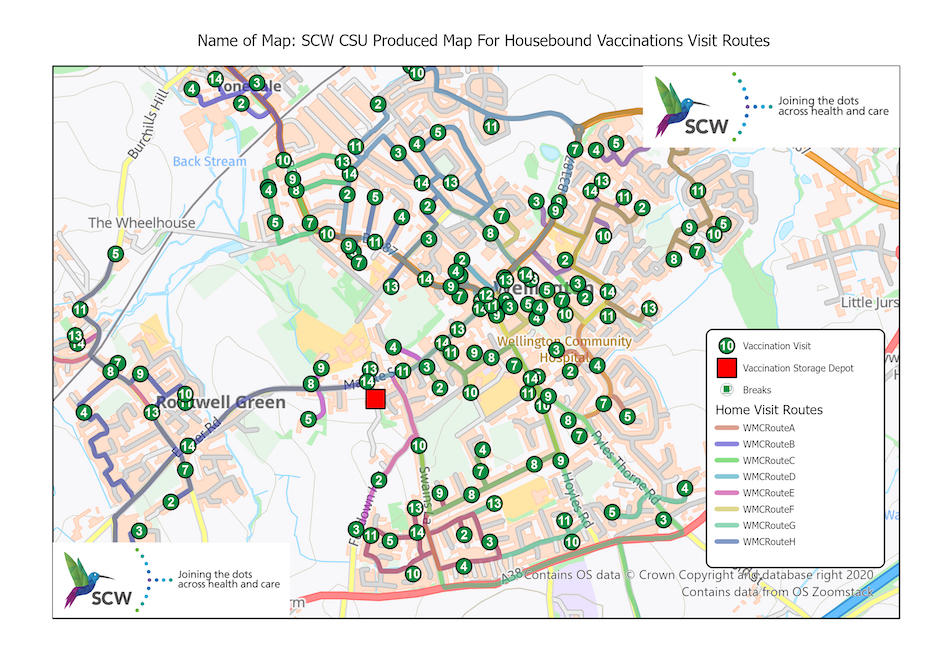The Challenge
How do you make sure housebound patients receive their Covid-19 vaccines in the most efficient way? PCNs in Somerset pondered this question as they began to rapidly roll out their COVID-19 vaccination programme.
The approach for the first round of vaccinations had turned out to be quite hectic. Allison Nation, Associate Director of Digital Strategy for Somerset CCG was approached by one of her PCN GPs, who asked, “Is there not some clever tech the CSU have, such as mapping?”
Allison immediately thought of Trevor Foster, associate director at SCW CSU and his GIS (Geographic Information System) mapping team and approached them for help with the project. Always ready to rise to a challenge, Trevor and his team said, “of course we can, that’s exactly what we can do” and rapidly started working on it. The need for speed was escalated as a second PCN in Somerset wanted the solution urgently for their 200 housebound patients.
The Solution
In planning how vaccinators go out and see patients there were a few parameters to consider, including, where is the vaccine stored? What time of day do vaccinators start and finish? And once open, the vial contents last 6 hours and within this time up to 11 jabs need to be completed.
Trevor’s team were able to take all the patient addresses and plan the optimal routing to cover as many patients as possible, in as few journeys, so they can fit within the time window for the vial. This is achieved by modelling a structured data set which contains a unique patient identifier, such as NHS or EMIS system number, and the full address to pinpoint specific house locations. Using this data, the analysis creates the fewest number of trips needed over the time period.
Each route is sequenced from start to finish, giving the order in which the mapping tool recommends the visits be done. The sophisticated modelling also builds in other relevant factors. These include breaks, households with more than 1 patient, time taken to ring the doorbell, chat with the patient, give the jab and sit with patient for 15 minutes recovery. The journey data is supplied in a spreadsheet with a map providing a visualisation of the routes. Each location is shown as a dot on the map. These are then clustered into groupings to match the dosage and time requirement. Routes can include patients from multiple practices within the PCN with GPs vaccinating each other’s patients to increase efficiency.
The GIS team was able to react extremely quickly to the original request. Using their expertise with Esri GIS software they were able to build the original model and procedures in less than 2 weeks from initial contact on 22 January, to launching a full solution to the PCN on 4 February.
The Benefits
Crucially, the solution minimises wastage of the vaccine and PCNs can plan thoroughly and communicate with patients in advance. Patients in each cluster will know when to expect their visits and vaccinators can call patients to confirm an accurate time. The model also builds in contingency time for unexplained delays which maximises the vaccination programme success rate.
The routing solution is saving the PCNs time and money. Before working with the GIS team, the PCNs planning was often not optimised and journeys quite chaotic. This resulted in increased journey times. Not only was it taking longer but fewer doses being given per day. This increased the number of days needed for vaccinations and consequently the cost of delivering the programme.
The mapping solution can be used to improve vaccination planning for the remaining first jab patients’ who are housebound, and to plan the second round of jabs and enable these to be managed more efficiently.
Using their expertise to model the data and interpret requirements into logical solutions, the GIS team were able to deliver the initial development in less than 2 weeks. With development of all the procedures now complete, and any pitfalls already resolved, the solution is now ready to be set up for new PCNs within only 1-2 days, provided good patient data is supplied (templates are provided).
Patient confidentiality is protected as no patient identifiable data is transferred from practices. Patient name and contact details are matched only within the practice and they follow up to make appointments. The solution has been developed using proprietary Esri commercial software which SCW owns, so the system is secure.
The data used is the most accurate available. As an Ordnance Survey (OS) partner, SCW has access to specific OS products to deliver this accuracy. To calculate the routing, it using the OS national routing network dataset. It also uses the OS national official addresses of the UK, address base premium, to pinpoint specific households, minimising time to find patients.
END
“A well organised, professional and highly responsive team, who clearly wanted to help our local practices as part of the PCN COVID Vaccination programme, in planning large groups of vaccinations for housebound patients. The SCW GIS team engaged to understand the need and context, and were quick to identify the key questions, dataset, work through relevant information governance and technical details. Clarity was sought when needed and issues addressed in a timely manner. A great outcome in a high-paced programme!”
Allison Nation, Associate Director – Digital Strategy, Somerset CCG
“The SCW GIS team assisted at short notice in allocating our 220-ish housebound patient groups into ordered geographical groups. With three practices and crossing over lists/geographical areas, it is a way in which the housebound vaccinating can be organised without the need for agonising lists and cross referencing between practices. The templates are clear and functional and the time allocation per vial of AZ 6 hours, as well as sensible prediction of times with patients, allows a clear representation of what is possible. The team add in the travelling times and provide a clear estimation of total time required per vial. We have found the team approachable and responsive. They have risen to our last-minute demands with efficiency and professionalism. In short, the exercise has been time well spent.”
Dr Sally di Mambro, GP principle/partner at Wellington Medical Centre/Taunton Deane West PCN
—
About NHS South Central and West CSU:
Based in the south of England, SCW’s team of 1,300 skilled professionals provides expert support for more than 80 NHS and non-NHS customers – nationally, regionally and locally. We are proud to be making a difference for 14 million people across an area of 15,600 square miles. As a delivery partner for 13 STPs (Sustainability and Transformation Partnerships),
This is a really great piece by @health1tech about our GIS mapping tool used to deliver vaccinations to housebound patients https://t.co/MXr4Jmix5c #GIS @esriuk
— SCW (@NHSscw) February 24, 2021

